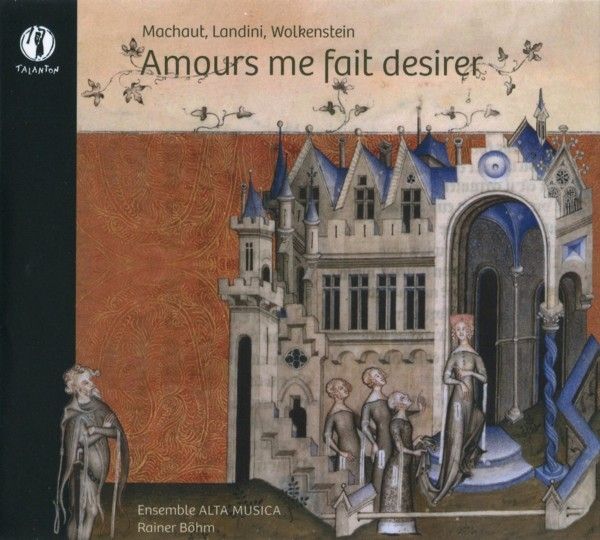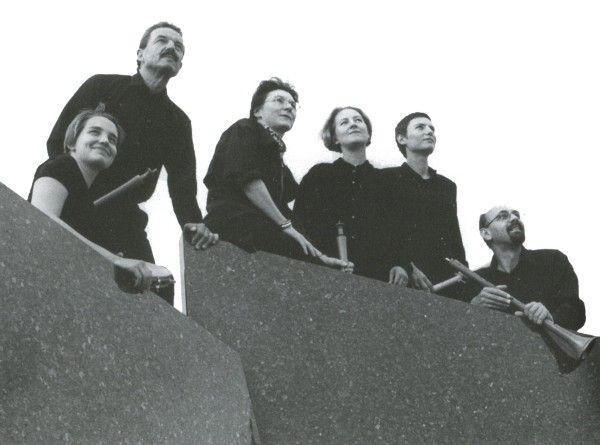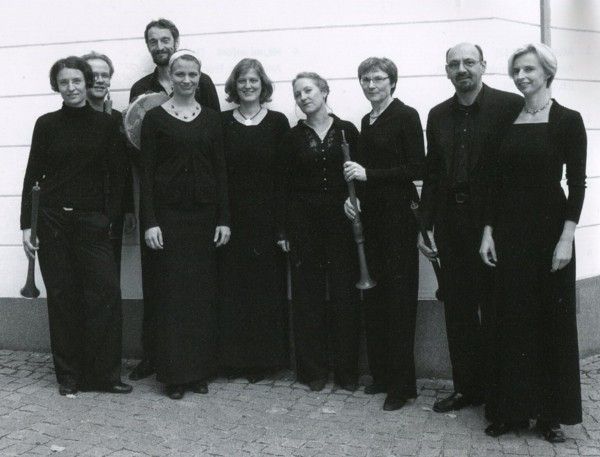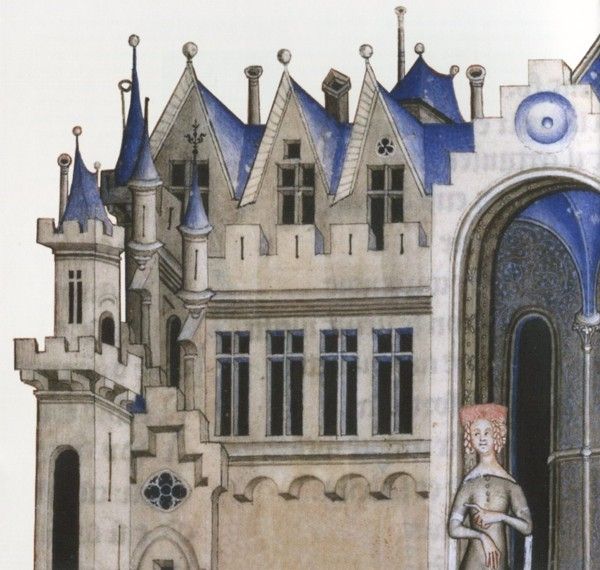
medieval.org
Talanton TAL 90004
2011
grabaciones de 2004/2005

medieval.org
Talanton TAL 90004
2011
grabaciones de 2004/2005
1. Alleluya [1:12]
Anonymus, Frankreich 13. Jh. · rb, cs, dj, mm
2. Non aurà ma' pietà [4:18]
Francesco Landini ca. 1325-1397
· mk, rb, pp
3. Je ne cesse de prier [2:24]
Guillaume de Machaut ca. 1300-1377
· pp, rb
4. La harpe de mélodie [4:11]
Jacob de Senleches ca. 1378—ca. 1395 · mk, rb, pp
5. Hé, tres douce rossignol jolie [3:14]
Jehan Robert ca. 1380—ca. 1409 · rb, dj, hb
6. De toutes flours [5:42]
Guillaume de Machaut · mk,
rb, pp
7. Frew dich, du weltlich creatur [4:53]
Oswald von Wolkenstein ca. 1377-1445
· as, rb, pp
8. Je vivroie liement [2:16]
Guillaume de Machaut · mk,
dj, pp, rb, hb
9. Hé, mi enfant [1:45]
Anonymus, Frankreich 13. Jh. · rb, cs, dj, mm
10. Amours me fait desirer [4:42]
Guillaume de Machaut · mk,
rb, pp
11. Plasanche or tost [1:49]
Nicholas Pykini ca. 1364-1389 · rb, ce, dj, hb
12. Es leucht durch grow [7:59]
Oswald von Wolkenstein · js,
pp, rb, hb
13. lstanpitta Ghaetta [6:01]
Anonymus, 14. Jh. · pp, rb, mm, hb
14. Che pena è quest'al cor [4:16]
Francesco Landini · js, as,
cs, rb, pp, hb
15. Se cuer d'amant [1:29]
Baude Cordier ca. 1380-1440 · rb, dj, hb
16. Muort' oramai [6:03]
Francesco Landini · js, as,
cs, rb, dj, pp
Produktion: Sebastian Pank (Talanton),
Rainer Böhm
QUELLEN
Ensemble Alta Musica
Rainer Böhm
Anja Schumacher · Alt (as)
Caroline Schneider · Schalmei, Alt (cs)
Dagmar Jaenicke · Blockflöten, Pommer (dj)
Hans-Jürgen Burggaller · Fidel, Pommer (hb)
Petra Prieß · Fidel (pp)
Michael Metger · Percussion (mm)
Rainer Böhm · Blockflöten, Schalmei, Saitentambourin
(rb)
Tonmeister: Manuel Dörr, doerraudio music production, Thomas
Görne
Aufnahme: Andreaskirche Berlin, 15. bis 17. September 2003, 29. Oktober
bis 2. November 2004
Bologna, aka Museo Bibliograpco Musicale, gis: Se cuer d'amant
Chantilly, Musée Condé, MS 564: Hé tres douce
roussignol jolie · La harpe de mélodie
Faenza, Biblioteca Comunale, Cod. 117, Codex Faenza: De toutes
flours (Tenor)
Firenze, Biblioteca Medicea-Laurenziana, Palatino 87, Squarcialupi
Codex: Non avrà ma' pietà · Che pena é
quest'al cor · Muort' oramai!
London, British Library, add. 29987: Istanpitta Ghaetta
Montpellier, Faculté de Médecine MS H 196: Alleluya
· Hé, mi enfant!
Paris, Bibliothèque Nationale, frg. 1584: Je vivroie liement
· Amours me fait desirer · Je ne cesse de prier
Paris, Bibliothèque Nationale, MS fonds novv. acq. frg. 6771,
Codex Reina: Plasanche or tost · De toutes flours!
Wien, Ostereichische Nationalbibliothek, Cod. 2777, Wolkenstein
Handschrift A: Es leucht durch grow · Frew dich, du weltlich creatur

Amours me fait desirer
Liebeslieder des 14. Jahrhunderts
Das 14. Jahrhundert war in der Musik eine Zeit bedeutender Neuerungen.
Notation, Harmonie, Polyphonie und Rhythmus erfuhren weitreichende
Veränderungen, wodurch sich völlig neue Wege eröffneten.
Heute wird diese wichtige Epoche von 1320 bis ca. 1370 in der
französischen Musik deshalb als Ars nova
bezeichnet, womit sie von der noch den alten Regeln gehorchenden Ars
antiqua unterschieden wird. Im letzten Drittel des 14.
Jahrhunderts erprobten einige Komponisten die neu entwickelten Systeme
bis an die Grenzen des Möglichen. Für diese Musik wird heute
der Begriff Ars subtilior benutzt.
Das einleitende Stück der CD, das Alleluya, stammt ebenso
wie Hé, mi enfant aus einer Handschrift mit
Motetten des 13. Jahrhunderts. Beide Stücke gehören also noch
zur Zeit der Ars antigua. Sie sind mit Schalmeien und
Pommer eingespielt, den Instrumenten der Alta Capella.
Der überragende Dichter und Komponist des 14. Jahrhunderts in
Frankreich war Guillaume de Machaut (ca. 1300-1377). Machaut bereiste
im Gefolge verschiedener Dienstherren ganz Europa und war
Kirchenmusiker an der Kathedrale von Reims. Von keinem anderen
französischen Komponisten der Ars nova sind derart
viele Werke überliefert. Das liegt unter anderem daran, dass er an
der Niederschrift seiner Musik selbst mitgearbeitet hat, was im
Mittelalter nicht selbstverständlich war. Von Machaut sind das
Virelai (Tanzlied) Je vivroie liement, die Balladen De
toutes flours und Amours me fait desirer, sowie das hier
instrumental eingespielte Je ne cesse de prier zu hören.
Jacob de Senleches, ein ebenfalls französischer Komponist, war
nachweislich im letzten Viertel des 14. Jahrhunderts aktiv, in der Zeit
der heute so genannten Ars subtilior. Er arbeitete unter
anderem am Hof der lombardischen Adelsfamilie der Visconti, in deren
Diensten auch Francesco Petrarca einige Jahre stand. Von Senleches
stammt das kanonische Virelai La harpe de mélodie. Das
Stück ist in einer Handschrift als Rätselkanon
aufgeschrieben: Die Noten der Melodie befinden sich auf den Saiten
einer gezeichneten Harfe. Auf einer um den Harfenschaft gewickelten
Banderole steht die Anweisung zur Aufführung des Kanons.
Auch Jehan Robert und Nicholas Pyikini sind Komponisten des späten
14. Jahrhunderts. Die Chansons Plasanche or tost von Pykini und
Hé, tres douce rossignol jolie von Robert sowie das
Rondeau Se cuer d'amant uon Baude Cordier interpretieren wir
hier mit den Instrumenten der Alta Capella.
Oswald von Wolkenstein (ca. 1377-1445) ist der Dichter des Marienliedes
Es leucht durch grow. Auf dieselbe Melodie hat Oswald vier Texte
ganz unterschiedlicher Thematik geschrieben. Da man davon ausgehen
kann, dass Oswald von Wolkenstein mehrstimmige Stücke nicht selbst
komponierte, ist sein marianisches Liebeslied Frew dich, du
weltlich creatur höchstwahrscheinlich eine Kontrafaktur auf
ein bis heute nicht identifiziertes Stück.
Die anonym überlieferte Istanpitta Ghaetta gehört zur
Gattung der Estampie (Instrumentalmusik), die im Mittelalter eher
selten aufgeschrieben wurde. Sie entstammt einer Handschrift mit
italienischer Musik des 14. Jahrhunderts, die sich heute in der British
Library in London befindet.
Der wichtigste italienische Komponist des 14. Jahrhunderts war
Francesco Landini (ca. 1325-1397). Die Anzahl seiner Kompositionen
macht rund ein Viertel der überlieferten Musik des Trecento aus.
Schon zu Lebzeiten rühmten Zeitgenossen seine Musik. Der in
früher Kindheit erblindete Florentiner Organist hat
hauptsächlich Liebeslieder, sogenannte Ballate, gedichtet und
vertont. Diese Ballate waren im frühen Trecento ursprünglich
Tanzlieder, sind aber bei Landini zu einer kunstvoll stilisierten Form
ausgebaut. Ganz im Stil der höfischen Minne werden in ihnen
Schmerzen, Leiden und Freuden der Liebe besungen, wie schon bei den
Troubadours, Trouvères und Minnesängern der vorangegangenen
Jahrhunderte. Besonders schön zeigt Landinis Ballata Muort'
oramai seine feinsinnige Art zu komponieren. Non aurà
ma' pietà, und Che pena è quest'al cor sind
zwei weitere Ballate Landinis. Instrumentalversionen dieser beiden
Lieder befinden sich auch im Codex Faenza, einer Tabulatur-Handschrift
des 15. Jahrhunderts mit zweistimmigen Instrumentalbearbeitungen
polyphoner Liedsätze. Das zeigt, wie beliebt Landinis Musik auch
im 15. Jahrhundert noch war.
Rainer Böhm

Amours me fait
desirer
Lovesongs of the Fourteenth Century
For music, the fourteenth century was a time of important innovations.
Notation, harmony, polyphony, and rhythm experienced wide-reaching
modifications, thus opening entirely new paths. For this reason, the
music of this important epoch from 1320 to ca. 1370 is today referred
to as the Ars nova, to distinguish it from the Ars
antiqua that was still based on the old rules. During the last
third of the fourteenth century, several composers pushed the newly
developed systems to the Limits of that which was possible. This music
is today known by the term Ars subtilior.
The opening piece on the CD, the Alleluya, as well as Hé,
mi enfant are from a thirteenth-century manuscript of motets. Both
pieces thus belong to the period of the Ars antiqua.
They are played here on shawms and bombarde (bass shawm), the
instruments of the alto capella.
The preeminent poet and composer of fourteenth-century France was
Guillaume de Machaut (ca. 1300-1377). Machaut travelled throughout
Europe in the entourage of various employers, and was a church musician
at the cathedral in Reims. More works by Machaut have come down to us
than from any other French composer of the Ars nova.
This is due, among other things, to the fact that he himself
participated in writing down his music, something that was not a matter
of course in the Middle Ages. To be heard here by Machaut are the
virelai (dance song) Je vivroie liement, the ballads De
toutes flours and Amours me fait desirer, as well as the
instrumentally performed Je ne cesse de prier.
Jacob de Senleches, likewise a French composer, is known to have been
active during the last quarter of the fourteenth century, at the time
of the so-called Ars subtitior. He worked, among other
places, at the court of the noble Visconti family in Lombardy, whom
Francesco Petrarca also served for a number of years. Senleches is the
composer of the canonic virelai La harpe de mélodie. The
piece is notated in a manuscript as a riddle canon: on a drawing of a
harp, the notes of the melody are written on the strings. Instructions
for the performance of the canon are on a banderole wound around the
harp's pillar.
Jehan Robert and Nicholas Pykini are also composers of the Late
fourteenth century. We interpret the chansons Plasanche or tost
by Pykini and Hé, tres douce rossignol jolie by Robert,
as well as the rondeau Se cuer d'amant by Baude Cordier with the
instruments of the alto capella.
Oswald uon Wolkenstein (ca. 1377-1445) is the poet of the Marian song Es
leucht durch grow. Oswald wrote four texts on entirely different
subjects to the same melody. Since it can be assumed that Oswald uon
Wolkenstein did not himself compose polyphonic pieces, his Marian love
song Frew dich, du weltlich creatur is most likely a
contrafactum of an as yet unidentified piece.
The anonymously preserved istanpitta Ghaetta belongs to the genre of
the estampie (instrumental music), which was rather rarely written down
in the Middle Ages. It is from a manuscript of Italian music of the
fourteenth century, which is today preserved in the British Library,
London.
The most important Italian composer of the fourteenth century was
Francesco Landini (ca. 1325—1397). His compositions make up
around a quarter of the surviving music of the trecento. Already during
his lifetime, his music was highly praised by his contemporaries. The
Florentine organist, who was blind from early childhood, mainly wrote
and set to music love songs, so-called ballate. In the early trecento,
these ballate were originally dance songs, but Landini expanded them
into an elaborately stylized form. Entirely in the style of the courtly
minnesong, the pangs, sufferings, and joys of love were expressed in
song, as previously by the troubadours, troovères, and
minnesinger of the preceding centuries. Landini's ballate Muort'
oramai shows in a particularly beautiful way his sensitive manner
of composing. Non avrá mai pietà and Che pena
è guest'al cor are two further ballate by Landini.
Instrumental versions of both these songs are also found in the Faeza
Codex, a fifteenth-century tablature manuscript with two-part
instrumental arrangements of polyphonic song settings. This shows how
popular Landini's music remained even into the fifteenth century.
Rainer Böhm
Translation: Howard Weiner
